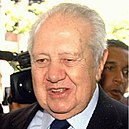Portuguese legislative election, 1980
|
|
|||||||||||||||||||||||||||||||||||||
|---|---|---|---|---|---|---|---|---|---|---|---|---|---|---|---|---|---|---|---|---|---|---|---|---|---|---|---|---|---|---|---|---|---|---|---|---|---|
|
|||||||||||||||||||||||||||||||||||||
|
250 seats to the Portuguese Assembly 125 seats needed for a majority |
|||||||||||||||||||||||||||||||||||||
|
|||||||||||||||||||||||||||||||||||||

The first and the second most voted parties in each district
(Azores and Madeira are not shown) |
|||||||||||||||||||||||||||||||||||||
|
|||||||||||||||||||||||||||||||||||||
| Portugal |
 This article is part of the series: |
This article is part of the series:
Politics and government of
Portugal
The Portuguese legislative election of 1980 took place on 5 October. In January 1980, the Democratic Alliance, which had won the previous election, on 2 December 1979, entered office with Francisco Sá Carneiro leading the government. However, this election was an extraordinary election, and so, in 1980, another election was held.
The major parties involved and the respective leaders:
The leader of the Democratic Alliance, Francisco Sá Carneiro, member of the Social Democratic Party was nominated Prime-Minister.
1 Republican and Socialist Front results are compared to the combined totals of the Socialist Party in the 1979 election.
...
Wikipedia


